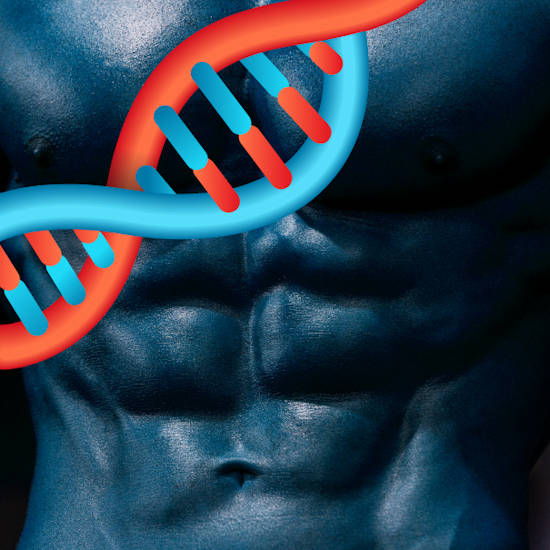Genetic Hacks for Six-pack Success

Genetics is the study of genes and their functions, which plays a crucial role in determining various physical traits and characteristics in humans. In the context of physical fitness, genetics can significantly influence how individuals’ bodies look, respond to exercise, and even recover from workouts.
The List of Genetic Hacks
- Know Your Body Type: Understand whether you’re an ectomorph, mesomorph, or endomorph, and tailor your fitness strategy accordingly.
- Customized Nutrition Plans: Use genetic testing to identify the best diet that suits your body’s specific needs, focusing on macronutrient balance and sensitivity to certain foods.
- Optimized Workout Routines: Based on your muscle fiber composition, decide whether you should focus on endurance or strength training to enhance muscle visibility.
- Leverage Your Metabolic Rate: If you have a slow metabolism genetically, incorporate metabolic training like HIIT to boost your calorie burn.
- Adjust for Adiponectin Levels: Increase foods high in omega-3 fats if you have lower adiponectin levels to improve fat metabolism.
- Manage Cortisol with Mindfulness: If you’re genetically predisposed to stress, include mindfulness practices to reduce cortisol and avoid abdominal fat accumulation.
- Sleep Better: Since genetics can affect sleep patterns, aim for 7-9 hours of quality sleep to improve muscle recovery and fat loss.
- Hydration and Hormonal Balance: Stay hydrated to maintain optimal hormonal balance, crucial for metabolizing fat.
- Track Your Progress Scientifically: Use tools like body composition scales to monitor your progress and adjust your plan as needed.
- Community and Motivation: Join communities that focus on genetic fitness to share tips, stay motivated, and keep learning about new genetic insights.
Impact of Genetics on Physical Fitness
Genetics determines a wide array of body attributes such as muscle composition, fat distribution, and metabolic rates. For instance, some people may naturally have a higher proportion of fast-twitch muscle fibers, making them better suited to sprinting and power activities. Conversely, others might have more slow-twitch fibers, enhancing their endurance. Such genetic predispositions can affect how easily individuals can develop muscle mass, including the abdominal muscles crucial for a six-pack.
Understanding Six-Pack Genetics
Genetic Factors Influencing Ab Visibility
The development of a visible six-pack is influenced by several genetic factors. These include:
Muscle Development Genes
Certain genes control muscle growth, strength, and muscle fiber type. Variations in these genes can affect how quickly and efficiently muscles develop, including the rectus abdominis—the main muscle that forms the six-pack.
Fat Distribution Genes
Genetics also dictates where and how fat is stored in the body. Some people are genetically predisposed to store less fat around their midsection, making it easier to achieve visible abs. In contrast, others might find it challenging to lose abdominal fat due to their genetic makeup.
Metabolic Rate Genes
Metabolism plays a vital role in how fast your body burns calories. Individuals with a naturally higher metabolic rate can burn fat more efficiently, which is beneficial when trying to reveal abdominal muscles.
How Genetics Affect Abdominal Muscles
Understanding these genetic factors helps clarify why some individuals may develop a six-pack more easily than others. It’s not solely about the amount of exercise or dieting but also about how conducive one’s genetic makeup is to developing visible abs.
Common Genetic Variations
Variations in the FTO Gene
The FTO gene, often referred to as the “fat mass and obesity-associated gene,” is one of the most studied in terms of its effects on body shape and fat storage. Variants of this gene can influence how your body stores fat and how difficult it may be to lose it. Individuals with certain variants of the FTO gene may have a higher tendency to store fat, particularly around the abdomen, which can make sculpting visible abs more challenging.
Adiponectin and Its Genetic Influence
Adiponectin is a hormone involved in regulating glucose levels as well as fatty acid breakdown. Genes that affect the levels of adiponectin can influence body fat percentage and fat distribution. Higher levels of adiponectin are associated with lower levels of body fat and can facilitate fat loss around the abdominal area, aiding in the development of a six-pack.
Impact on Achieving a Six-Pack
These genetic variations demonstrate why some people might find it easier to lose abdominal fat and develop muscle definition compared to others who might struggle despite rigorous diet and exercise routines. Understanding these genetic factors can help tailor more effective fitness strategies.
Insights from Geneticists
Genetic and Environmental Interplay
Geneticists emphasize that while genetics provide the framework, environmental factors such as diet, exercise, and lifestyle choices play a significant role in achieving fitness goals. The interaction between genes and the environment can dramatically influence the effectiveness of fitness efforts.
Expert Opinions and Research
Prominent geneticists and fitness researchers have highlighted studies showing the significant influence of genetics on muscle development and fat loss. For example, research indicates that some individuals respond better to certain types of exercise due to their genetic makeup, which can be crucial for effectively targeting abdominal muscles.
Practical Advice from Genetic Research
Insights from genetic research suggest that personalized fitness plans that consider an individual’s unique genetic makeup could enhance the ability to achieve and maintain a six-pack. Experts recommend genetic testing for those who are serious about tailored fitness strategies, as this can provide valuable information on how to optimize workouts and diet plans.
Advice from Fitness Experts
Tailoring Workouts to Overcome Genetic Disadvantages
Fitness experts often suggest that overcoming genetic disadvantages requires a tailored approach to exercise. For those who struggle with fat accumulation around the abdomen, incorporating high-intensity interval training (HIIT) can boost metabolism and enhance fat loss. Strength training, particularly compound movements like squats and deadlifts, can also help increase overall muscle mass and reduce body fat percentage, making abdominal muscles more visible.
Dietary Recommendations
Nutrition plays a critical role in defining abs. Experts recommend a diet high in protein to support muscle growth and repair, combined with a moderate intake of healthy fats and carbohydrates for energy balance. Reducing sugar and processed foods is essential for those with a genetic tendency to store abdominal fat. Instead, focusing on whole foods can improve overall health and aid in fat loss.
Lifestyle Changes for Better Results
Stress management and sleep are often overlooked aspects of fitness. Fitness professionals emphasize the importance of quality sleep and stress reduction techniques like meditation or yoga, as elevated stress levels and poor sleep can lead to increased cortisol, which is linked to fat accumulation in the midsection.
Working with Your Genetic Makeup
Importance of Personalized Fitness Plans
Understanding one’s genetic makeup can significantly enhance the effectiveness of fitness regimes. Genetic testing can provide insights into how an individual’s body responds to different types of food and exercise, allowing for a more personalized approach to fitness that maximizes results.
Adjusting Exercise Strategies
For those with genetic variations that affect muscle gain, such as variations in the ACTN3 gene, adapting exercise strategies to include more resistance training may be beneficial. Resistance training can help in building muscle mass, even for those who are genetically predisposed to having less muscle density.
Nutritional Adjustments Based on Genetics
Genetic insights can also guide dietary adjustments. For example, individuals with a genetic predisposition to insulin resistance might benefit from a lower carbohydrate intake. Similarly, those with variations in the MTHFR gene might require more folate-rich foods to optimize metabolism and muscle function.
Long-Term Planning
Finally, working with a fitness professional to continually assess and refine fitness and diet plans based on progress and genetic feedback can help individuals stay on track towards achieving their six-pack goals and maintaining them long-term.
In the quest for a six-pack, understanding the complex interplay between genetics and lifestyle choices is crucial. While genetics set the stage, tailored strategies in exercise, diet, and lifestyle can effectively overcome genetic limitations. Armed with personalized insights and expert advice, anyone can enhance their potential for achieving and maintaining well-defined abs. By embracing a comprehensive and customized approach, you can navigate your fitness journey with confidence, turning genetic knowledge into power for your transformation.

Travis is the lead content developer on SixpackShortcut.com He also writes in the wellness and outdoor space. On SixpackShortcut.com Travis specializes in sixpack product reviews and informative articles.